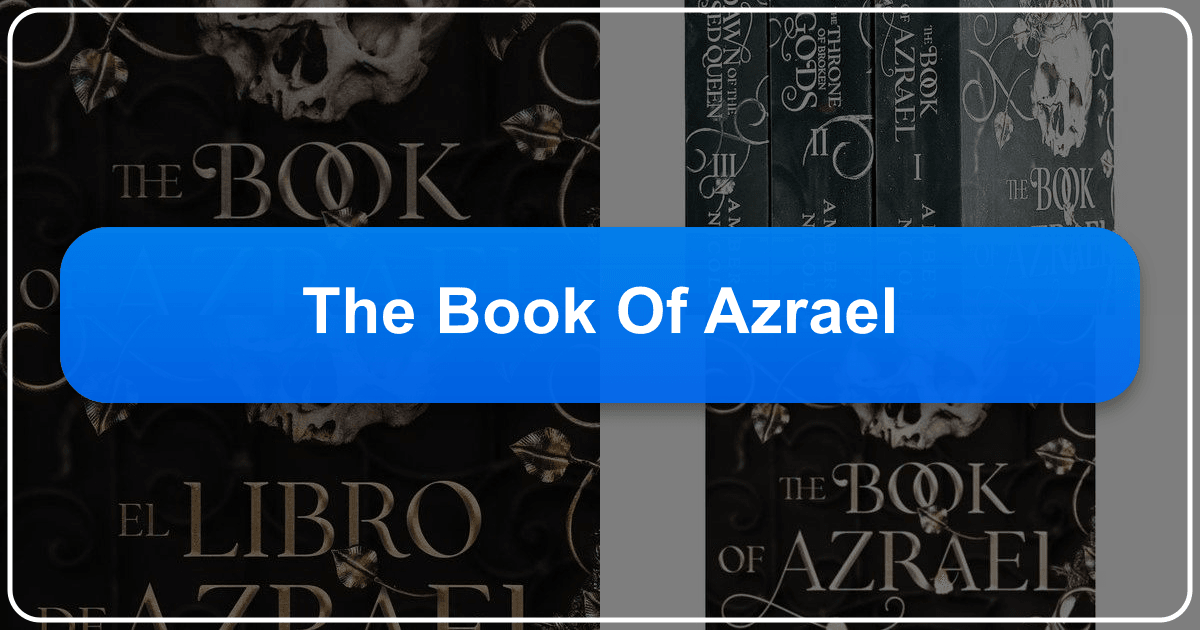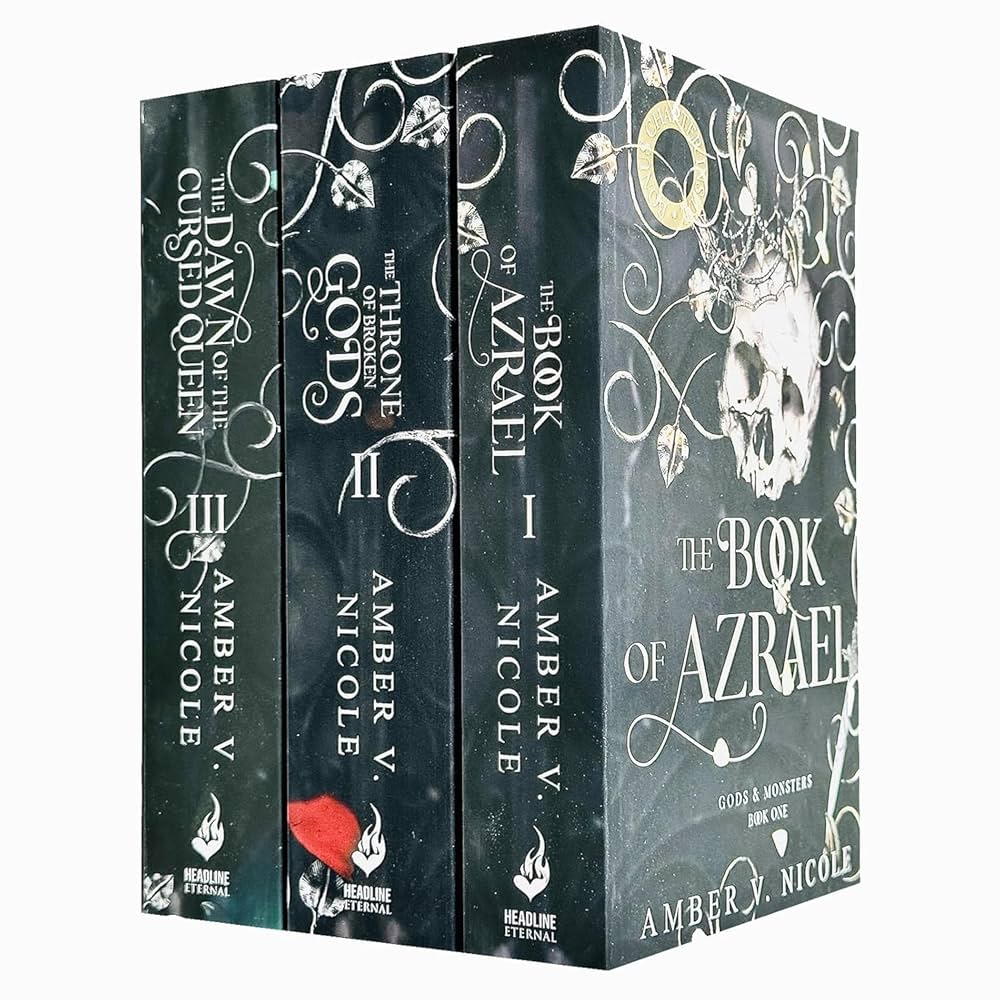The Book of Azrael: A Deep Dive into Amber Nicole's Dark Romantasy Epic

Amber Nicole’s “The Book of Azrael” has ignited the BookTok community, earning widespread praise for its unique blend of dark fantasy, romance, and intricate world-building. This in-depth review explores the novel’s various aspects, examining its plot, characters, romance, world-building, and cultural impact, drawing heavily on reader reviews and Goodreads discussions.
A World Divided: Plot Summary and Key Themes
The narrative revolves around the quest for the Book of Azrael, a powerful artifact capable of opening interdimensional gateways and holding the celestial secret to defeating the “World Ender.” Kaden, the ruthless king of monsters, seeks the book to reshape the world in his image. Dianna, a fiercely independent and morally grey warrior reborn with formidable powers, serves as Kaden’s second-in-command, but her allegiance is tested when she encounters Liam, also known as Samkiel, the prophesied World Ender.

The story unfolds as Dianna and Liam, enemies since the dawn of time, are forced into an uneasy alliance to prevent Kaden from obtaining the Book of Azrael. Their journey takes them across multiple realms, forcing them to confront their past traumas and prejudices as they develop a complex, enemies-to-lovers relationship. The plot is characterized by high-stakes action, shocking betrayals, and unexpected twists, culminating in a heart-wrenching cliffhanger that leaves readers craving the next installment. The central themes explored in the book include the nature of good and evil, the power of love and redemption, and the consequences of past actions.
Building a Complex World: World-Building and Magic System
Nicole’s world-building is a significant strength of “The Book of Azrael.” The intricate details of the Etherworld, a complex tapestry woven from ancient myths and modern societal elements, create a fully immersive reading experience. Readers are captivated by the unique power system, featuring diverse beings like gods, monsters, witches, vampires, and mortals, each with their own unique abilities and histories. The author deftly avoids information dumps, skillfully weaving world-building elements into the narrative, allowing the reader to gradually unravel the complexities of this captivating setting. The balance between ancient lore and modern elements, such as Dianna and Liam’s interactions with contemporary society, adds a fresh and engaging dimension to the fantasy elements.

Character Analysis: Dianna and Liam, and Their Compelling Dynamic
Dianna and Liam are complex characters with compelling arcs. Dianna is described as a ruthless, fiery, and morally grey female protagonist, a “badass fmc” in the words of many readers. Her snarky attitude, strength, and selflessness mask a vulnerability born from a past sacrifice. Her deep love for her sister Gabby drives her actions, even as she commits morally questionable deeds to protect her. Dianna’s journey is one of self-discovery and healing, as she grapples with her past and the weight of her choices. Many readers compare her favorably to other iconic morally grey female leads.

Liam, or Samkiel, is the brooding, traumatized “World Ender,” suffering from PTSD and depression stemming from the destruction of his home world. Initially stoic and withdrawn, he slowly opens up to Dianna, revealing his vulnerabilities and capacity for love. His character arc involves healing from his trauma and learning to trust again. The contrast between his ancient wisdom and his struggle with modern society adds depth to his persona.
The dynamic between Dianna and Liam forms the emotional core of the novel. Their initially hostile relationship gradually evolves into a slow-burn romance, fueled by sexual tension, deep-seated affection, and a shared determination to save the universe. Readers praise the “enemies to lovers” aspect, citing the realistic progression of their bond and the palpable chemistry between them. The banter and humor woven into their interactions are recurring sources of enjoyment for readers. Their relationship, built on mutual respect and understanding, despite their vastly different backgrounds and beliefs, adds to the story’s appeal.
Forbidden Love and Enemies-to-Lovers Trope
The romantic relationship between Dianna and Liam is a significant part of the book’s narrative and central to its appeal. The “enemies-to-lovers” trope is explored effectively, with the tension between them simmering throughout the story, slowly building into a passionate bond. The forbidden nature of their love, due to their different origins and the centuries-old conflict between their races, adds another layer to their compelling dynamic. The slow-burn aspect of their romance is frequently commended, as is the author’s ability to create a believable and engaging progression of feelings, avoiding rushed or forced developments.
Beyond the Pages: Cultural Impact and Reception
“The Book of Azrael” has achieved significant traction, particularly among young adult and fantasy readers. It has garnered significant attention on social media platforms such as TikTok and Goodreads, leading to numerous discussions and reviews that highlight the novel’s strengths and weaknesses. Readers often praise the engaging plot, well-developed characters, and immersive world-building. The unique mix of dark fantasy, epic scope, and heartfelt romance, resonating with readers who enjoy complex characters and high-stakes adventures.
The book’s positive reception has contributed to the growing popularity of the “dark romantasy” subgenre, blending elements of dark fantasy with intense romantic narratives. This success has also established Amber Nicole as a rising author in the genre, with readers eagerly anticipating the continuation of the series.
Reader Reviews: A Spectrum of Opinions
While generally positive, reader reviews reveal a range of opinions. Many praise the complex character development, unique world-building, and engaging romance. The enemies-to-lovers trope and slow-burn romance receive particular acclaim, praised for their believable progression. The unique setting is also mentioned, a distinctive feature that captivates readers. However, some readers criticize the writing style, noting instances of clunky phrasing or inconsistencies in the narration. Others find the length of the book excessive, or feel that the pacing is uneven. The ending is widely debated, with some finding it predictable, and others describing it as exciting. A variety of comments also deal with editing concerns, such as the presence of typos and grammatical errors.
Despite some critiques, the overall reception is overwhelmingly positive. The widespread interest in the novel and its strong performance on sales charts demonstrate a significant impact on the fantasy fiction market, and it has firmly secured Amber Nicole’s place as a noteworthy voice in contemporary dark romantasy fiction.
Conclusion: A Promising Start to a Larger Narrative
“The Book of Azrael” serves as a compelling starting point for a larger series. Its success is attributable to its unique world-building, intriguing plot, and well-developed characters, but some minor issues with the writing and editing suggest room for improvement in subsequent installments. Nevertheless, the passionate response of readers demonstrates the power of this story to engage and captivate its target audience. The cliffhanger ending leaves readers anticipating the next book, setting the stage for a larger and even more compelling narrative arc. The book’s success on BookTok and other social media platforms indicates that it is likely to further contribute to the growing popularity of dark fantasy romance, ensuring a continued audience and impacting the publishing industry’s trajectory in the genre.